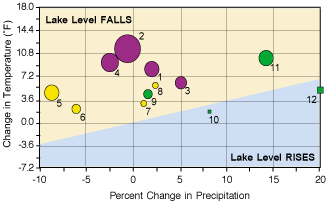Climate Change and Great Lakes Shipping and Boating
|
Great Lakes Water Resources — Lake Levels The Great Lakes/St. Lawrence Seaway is internationally shared resource used for shipping, transportation, fishing, and hydroelectric power generation. The Great Lakes are also one of the prime recreational boating areas in the country. The CGCM1 model used in the current assessment suggests a trend toward lower Great Lakes levels — a drop of 1.5 to 3 feet on the various lakes within the next 30 years. Output from the HadCM2 model suggests no change to a slight increase in lake levels. Ice cover will also likely decrease, both in terms of days with ice cover and thickness of ice.
Great Lake Regional Summary — Water Resources report (PDF) available here |
Lake Michigan-Huron
Lake Michigan—Huron comparison from selected climate change studies. The size of the marker is keyed to the magnitude of the change in lake level. The color represents different studies: the lavender ones (1-4) were taken from previous studies at the Great Lakes Environmental Research Laboratory (GLERL); the yellow ones (5-8) were taken from a recent study by Phil Chao; and the green ones (9-12) were done most recently —specifically for this assessment. |
||||
